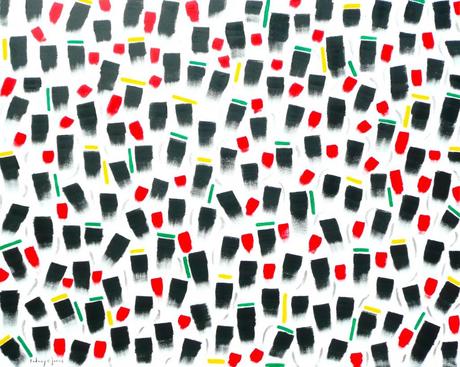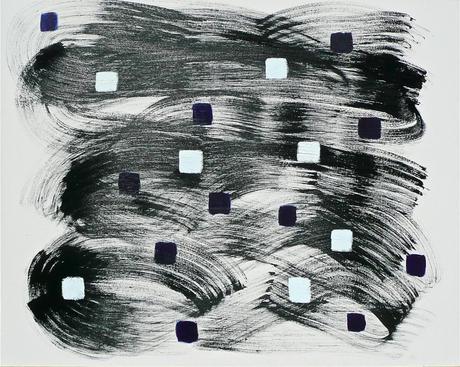Overtly I wasn’t influenced by any one style…and the same can be said about Jackson Pollock.
Pollock’s work evolved into a style that was light years away from his early work. Especially when you consider the influence Thomas Hart Benton had on Jackson when he attended the Art Student League of New York. After the usual trials, tribulations and angst all artist go through in trying to discover a style of their own Jackson in the early 1940′s developed his Compositions with Pouring. Thanks to an article published in Life Magazine, August 1949 his style all of a sudden became known as “Drip Painting”. A term that he never really embraced and his wife Lee especially abhorred. In an interview she was asked once if it’s not drip painting, then what would you call it? She fumbled around and could never really give a name to that painting style.
The 1950′s were some of the most productive years for Pollock. Many of his most famous Compositions with Pouring evolved at that time. The Tate Modern in the UK has one of my favorites Summertime and probably everyone’s all time favorite is Lavender Mist which currently resides at the National Gallery in Washington, DC.

Jackson Pollock - Summertime - Tate Modern - This painting gives off tremendous energy

Jackson Pollock - Lavender Mist- You have to experience it in person
I’ve studied the works of many abstract painters and I chose Pollock to compare myself to over Albers, Hoffman, Clyfford Still, Willem DeKooning and others because Pollock hit the proverbial wall. What do I mean by this? The tighter your style the less latitude you have for future development and evolution. Once Pollock started the dripping it was a blessing that ultimately led to his personal locked cell. No one can argue that his style made him famous and there were millions of artists trying to copy him world wide. I read that you couldn’t pass a corner in Manhattan without some artist trying to sell you their knock-off version of a Pollock. Fortunately the forgers of his style never could pump the emotion and spiritual awareness that Pollock brought to these amazing & original works of art.
Milton Resnick a member of the 10th Street Artist Group understood the dilemma of boxing yourself in creatively. He observed Pollock and many other artists, at the time, who developed a style and then the style became unpopular and their careers were pretty much over. Some recovered emotionally but many didn’t. Being known solely for one particular narrow style that isn’t flexible enough to adapt to all of the influences artists experience throughout their careers is a death knell. This is true for all the arts. You must reinvent your style but you must retain a resonating theme.
(Be sure and watch part 1 & 2 available on YouTube.com)
The question becomes…what do you do? There are numerous examples of artists who have made radical changes in their styles and never recovered the recognition that they once had. Gallery owners select artists based on their style and if they dare make a change their popularity quickly wanes. If you develop a unique style it’s critical that you as an artist make it as prolific as possible. You don’t want to be boxed in…but you do want to have a style that is easily recognized. Every painting should have somewhat of a common theme that can stand on its own and still be identified with the artist, while separating you from everyone else.

One of my earliest abstract paintings Hiway - Acrylic on canvas board Rod Jones Artist
Fortunately for me I developed my style rather quickly…for better or worse. My style which we’ve named Receptive Abstract Patternism (RAP) has a beginning but it has no end. I have only scratched the surface of this style. It’s flexible, dynamic, welcomes the creative use of artistic tools, has no color boundary, the only restrictive element is my imagination. Although I very much admire Pollock the artist (not so much the person), he boxed himself in. He even tried to reinvent himself by moving back to an earlier style but that never really jelled for him. The surviving girlfriend in the car accident commented that Jackson went out at the right time. It would have been painful to watch his talent fade. I suppose he could have come up with a new incredible innovative style, but I guess one will never know. It would have been interesting to see how he would have faired on the Internet and Web 2.0.

Another very early painting- Pandemonium- 48x48-Acrylic on Canvas- favorite painting of my younger sister- Rod Jones Artist
I spent a good part of my life making money with a camera. Not weddings & portraits, but advertising and fashion. You learn a lot about the creative process in that intense environment, especially when you succeed. I keep looking for the influences from that career and how that knowledge was transported into my style of art. The only correlation I can find and it’s loose at best, is composition. As far as color goes, I preferred black & white photography over color. My color sense probably comes from having a father who made and sold paint. There’s nothing like playing with color paint chip samples when you’re a kid. Something just gets imprinted. In fact..the use of geometric shapes probably is an extension of the paint chip. But like colors and shapes there always is a beginning and with luck, there may be no end in site. I know as my work develops there will be an ebb and flow from complicated to simplistic. But the nature of my somewhat thematic style will always be there. A dear friend once told me that I can recognize your work, but yet no two are alike. Leave it to a good friend to give you a comment that I will cherish and hopefully nurture.

Jazz Elation - 30x40- oil on canvas- Rod Jones Artist -This depth and gives off some pretty amazing energy in person

Loosely Contained Thoughts- 60x48-oil on Canvas-Rod Jones Artist - Simplicity with my signature style

Rosa Mystica- Oil on Canvas- 24x36-Rod Jones Artist-Layered Old Holland Paint manipulated with tools
Evolving…there are many new pieces that haven’t hit my website yet. Some are simple and some are painfully complicated, with literally hundreds of brush strokes. They each adhere to Receptive Abstract Patternism. I guess for now I am luckily stuck in the exploration and development of this style. The good news for me is it’s open ended.

